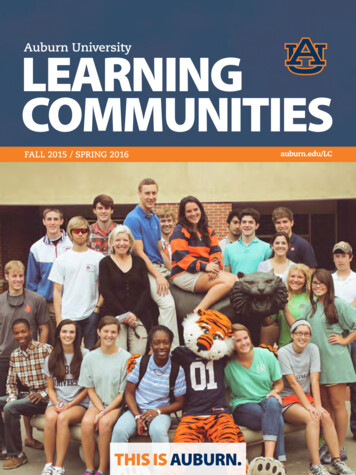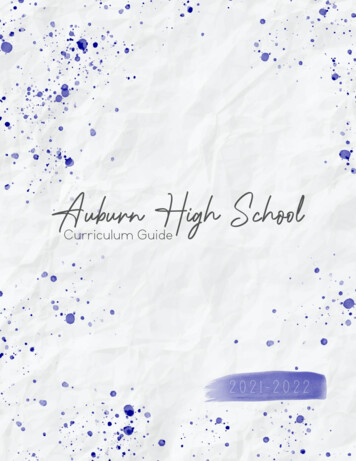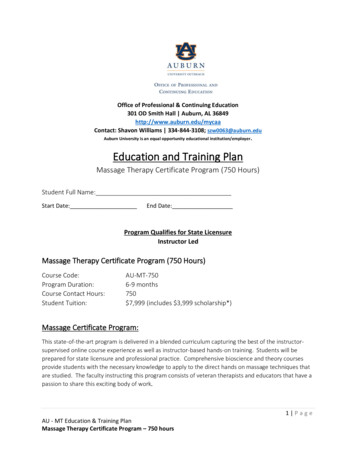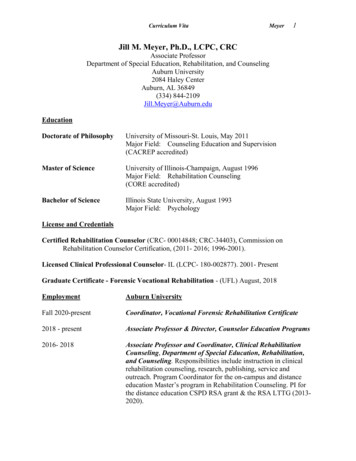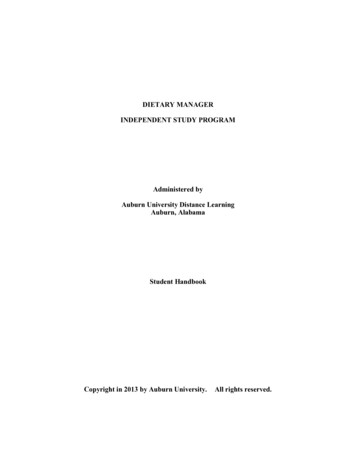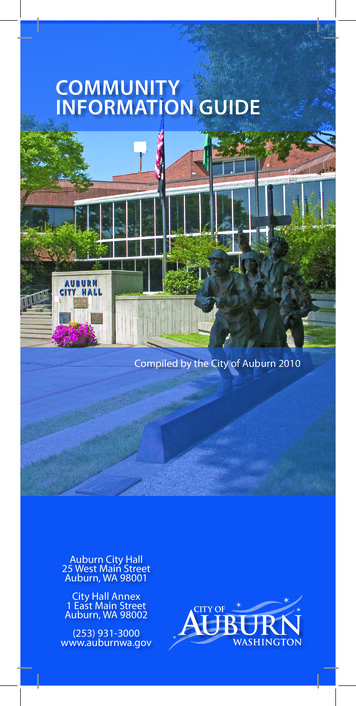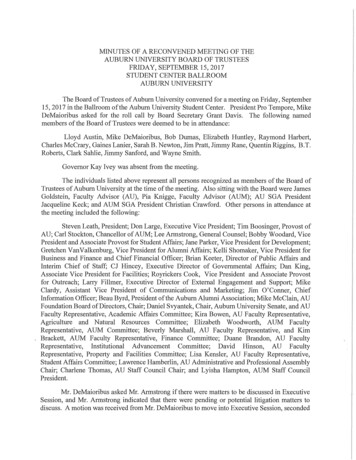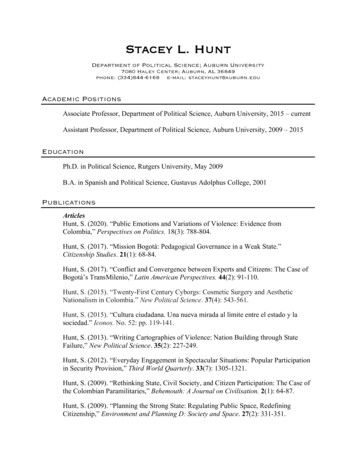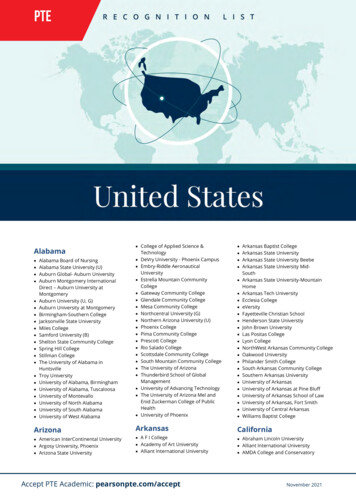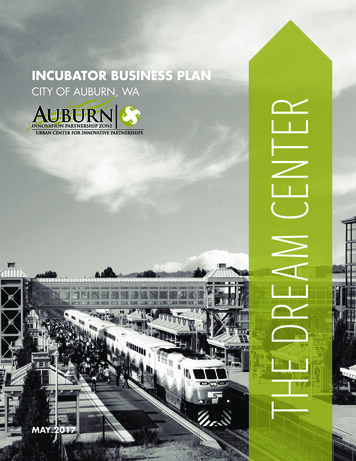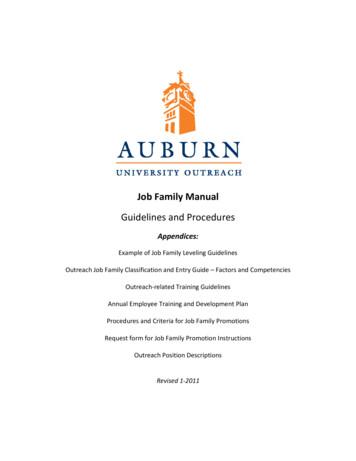
Transcription
Job Family ManualGuidelines and ProceduresAppendices:Example of Job Family Leveling GuidelinesOutreach Job Family Classification and Entry Guide – Factors and CompetenciesOutreach‐related Training GuidelinesAnnual Employee Training and Development PlanProcedures and Criteria for Job Family PromotionsRequest form for Job Family Promotion InstructionsOutreach Position DescriptionsRevised 1‐2011
1Job FamiliesExplanation and GuidelinesDefinitionA job family is defined as a series of progressively higher, related jobs distinguished bylevels of knowledge, skills, and abilities (competencies) and other factors, and providingpromotional opportunities over time.PurposeJob families: Improve competencies of the workforce through better selection and placement; Increase training and development participation; Increase retention of competent employees; Improve individual performance and contribution; Provide flexibility to line managers in staffing decisions; Provide flexibility to line managers when assigning job duties.General CharacteristicsJob families are designed to take advantage of successful human resource strategies suchas: General job descriptions; Broad salary structures; Flatter organizational structures; Competency/skill based salary management; Comprehensive position management; Decentralized position classification decisions; Greater emphasis on individual development.General FeaturesPlacing Jobs in a Job FamilyA job family is a series of jobs involving work of the same nature, but requiring differentlevels of skill and responsibility. For example, it is quite common to find an accountant’s job in ajob family. An entry level accountant would be one who has recently graduated from college,who has little experience, whose skills are being developed and who would be givenresponsibilities at a lower level than those with experience. On the other hand, a senior levelaccountant would be one with many years of experience whose skills and competencies areexemplary and who completes job duties of a high level. Thus, the value of an accountant varieswidely based on his/her experience, competencies, and the level of responsibilities beingcompleted.Not all jobs can be placed into a job family. Some jobs consist of very routinized,repetitive work. Others require extensive experience and specific competencies or credentialsprior to being placed into the job. The value of such jobs is typically more narrowly defined;therefore, such jobs are not placed into a job family.
2Defining Job Family LevelsJob families function to provide both a structure for departmental human resourcedecisions and a career ladder by which an employee may plan his/her professional growth andadvancement.A job description for a job within a job family describes, in broad terms, the duties andresponsibilities one would be expected to perform at the various levels within a job family. Thelevels within a job family are defined more on the competencies expected of the employee ratherthan a list of specific tasks and responsibilities. The number of levels for a job family isdetermined by the value of the job in the marketplace and to the institution.When recruiting for a position within a job family, the supervisor may recruit for a broadskill set ranging across several levels of a job family and then assign the specific level based onthe competency of the selected candidate. Promotions of individuals within a job family are tiedto demonstrated competencies and performance, completion of individual development activitiesand the needs of the department.Supervisors of employees in a job family have primary responsibility for deciding on thelevel of the job family assigned to an individual. Placement of an individual at a particular levelwithin a job family is dependent upon the competencies of the individual, the level ofresponsibility, and the needs of the department. However, employees in a job family are alsoempowered because promotions focus on individual performance, development and trainingbased on the competencies established for each level.Determining Salary Grade LevelsSalary grade levels for jobs within a job family are based on salary survey informationand internal equity. Auburn University uses a blend of salary survey information and an internaljob evaluation system to determine the value or salary grades for the various levels within a jobfamily.The assignment of an employee to a particular grade level in a job family is based on thecompetencies identified for each level. For example, entry level positions are characterized bymore routine work under close supervision. However, at the mid-range or intermediate levels,positions follow established guidelines, but work under more general supervision. Finally, at theadvanced level, incumbents are working more independently, and in some cases are leadingprojects or work in their area. The job description for a job within a job family has “job familyleveling guidelines” that provide descriptions of the responsibilities, knowledge and educationand experience required for each level of the job family. These “leveling guidelines” provide abroad description of the requirements of each level and are designed to assist a supervisor indetermining the appropriate level for an employee.Key Elements of Job FamiliesAssignment/Promotions to a level within a job family: Are based on identified competencies and needs of the department; Are based on supervisor recommendation and/or committee review;
3 Are made concurrent with annual budget cycle;Must follow the standard request/approval procedures.Performance standards: Focus on increasingly higher levels of responsibilities; Focus on individual competencies and acquisition of new competencies; Focus on contributions to team, departmental image and service; Must be met or exceeded to qualify for promotion to a higher level.Promotional opportunities: Are non-competitive; Must be initiated by supervisor based on organizational objectives; Are based on recognized increases in job responsibilities, competencies and quality of performance; Are based on completion of development plans, assigned training and/or time in service; Are considered and approved during annual job family promotion cycle only.Development/training opportunities: Are identified by the supervisor as part of annual performance review cycle; Are based on competencies established for each level; May include job enrichment activities, job rotation, AU HRD programs, in-house, on-the-job, and external sources.Salary adjustments: Are based on the availability of funds; Take internal equity issues into consideration; Use a standard university formula to determine maximum allowable salary increase; Are effective at the start of new the fiscal year; Could include exceptions where special competencies are identified, with approval of higher administration; Use central University funds (except those positions funded through a contract or grant).Job Family CommitteesThe University encourages the use of job family oversight committees to screen allapplications for job family promotions and to review and make recommendations regardingtraining and other requirements necessary to advance through the job family. Recommendationsfor job family promotions or changes in a job family are generally presented to the oversightcommittee for review and approval. Such committees are intended to ensure consistency inpromotional activity within a job family. The Human Resources Department can assist in thedevelopment and operation of such committees.
4Job Family Personnel ProceduresCreating a PositionTo establish a position in a job family, the initiating unit must follow the University’sstandard procedure for creation of a position. This will include: (1) a proposal demonstrating theneed for such a position and indicating the source (including any commitment of AuburnUniversity), amount, and term of funding for the position; (2) completion of a job questionnaire;and (3) approvals by the chief administrative officer of the concerned unit.Position VacanciesJob searches to fill a vacancy in an approved job family position will follow normaluniversity hiring procedures.Job Family Promotions and Review ProcessJob family promotions of eligible incumbent employees within a job family will becoordinated with the University’s fiscal cycle of budgetary planning. For those job families withan oversight committee, the job family oversight committee will review all applications for jobfamily promotions.Required forms and criteria for job family promotions are included in this manual toassist managers in submission of promotional applications for eligible employees.Job Family Training and DevelopmentPurposeThe goal of development programs is to define the quantity, content and sources ofaccessible programs which enable employees to fulfill competency expectations of the jobfamily, while allowing supervisors maximum flexibility in managing staff training. Suchprograms do not necessarily require a lock-step training sequence per level. Developmentprograms should be designed to promote an employee’s career objective and fulfill annualtraining and development activities which supervisors are expected to assign and employees areexpected to fulfill in order to qualify for future promotions within the job family. Additionalexpectations of professional and service activities, certifications, etc. may be assigned to theemployee by the supervisor as the employee progresses to the upper levels of the Job Family.General Professional DevelopmentUnder the category of General Professional Development, the Human ResourcesDevelopment Office offers training activities that stress the continuing development of humanresource related skills and abilities that are of major importance in job effectiveness, focusing onthe following categories: communications, leadership, service, teamwork, and processimprovement. The supervisor should assess the employee’s proficiency in each category todetermine development priorities. The existing curriculum of Auburn University HRD coursesoffers a broad range of programs in these categories. As the employee completes all appropriateAU HRD courses, the supervisor should substitute content from other sources to providecontinuing development in these categories throughout the career of the employee. Areas offocus could include:
5 CommunicationsLeadershipServiceTeamworkProcess improvement.Unit, Job Specific and/or Technical TrainingThis training is designed to improve an employee’s technical or professional knowledgefor his/her specific job. Areas of focus could include: AU Office Administration courses AU IT courses Self-directed courses External training providers On-line sources Training certifications (as identified for advanced level positions) Major disciplinary certifications and/or fellowships.Professional DevelopmentParticipation in appropriate professional activities enhances professional expertise andfosters an environment which promotes continued learning and improvement. Areas of focuscould include: Annual regional/national organizational participation (conferences, committees, presentations, papers) University service (committees, task forces, advisory teams).Approved Credit CoursesFollowing University guidelines for enrollment in credit programs and as approved byone’s supervisor, an employee’s participation in credit courses may be taken into account towardjob and professional development expectations on an ad hoc basis.DocumentationCompletion of training and assignments for the coming year should be documented aspart of the University’s standard annual performance planning and review process. Included inthe appendices of this document is a form “Annual Employee Training and Development Plan”which can be used to plan and track employee training and development activities.Applications for the annual cycle of Job Family planned program promotions shoulddocument training accomplishments. Though these applications are generally due in March, AUHuman Resources allows training completed before October 1 to count towards a job familymember’s promotional requirements for that year. For clarity, completion of such trainingshould be documented as “anticipated.”
6APPENDICESExample of Job Family Leveling GuidelinesOutreach Job Family Classification and Entry Guide – Factors and CompetenciesOutreach-related Training GuidelinesAnnual Employee Training and Development PlanProcedures and Criteria for Job Family PromotionsRequest form for Job Family Promotion InstructionsOutreach Position Descriptions
7Example of Job Family Leveling GuidelinesJob Family Name:Administrative Professional 3-LevelApplies to:Three-level administrative professional jobs. All jobs are exempt. This describes theminimum qualifications and the general level and type of work performed at each level ofthis job family. Promotions from a lower level to a higher level may require completionof additional criteria as outlined by the supervisor, department, or job family committee.Sample jobs: Accountant, Editor, Internal Auditor, Buyer, Career Counselor, AdmissionsAdvisor, Curator, Human Resources GeneralistLevelResponsibilityKnowledgeEducation &Experience1Under immediate supervision,performs standard tasks usingestablished methods, principles,concepts and procedures related toa specialized field. Judgments aremade on routine matters ofrelatively small impact.Under close supervision, performsvaried duties and assignmentsinvolving some judgment. Resolvesroutine questions or problems,referring only complex issues tohigher level. Some evaluation,originality and ingenuity required.Knows fundamentalconcepts, practicesand procedures ofparticular field ofspecialization.Bachelors degree indiscipline appropriateto position with noexperience.Knows and appliesfundamental concepts,practices andprocedures ofparticular field ofspecialization, withawareness of relatedfields.Possesses and applieda broad knowledge ofprinciples, practicesand procedures of aparticular field ofspecialization to thecompletion of difficultassignments. Alsopossesses knowledgeof related fields andareas of operationwhich affect, or areaffected by own area.Bachelors degree indiscipline appropriateto position plus 2years experience.Experience mustinclude at least 2 yearsat the preceding levelor equivalent.Bachelors degree indiscipline appropriateto position plus 4years experience.Experience mustinclude at least 2 yearsat the preceding levelof equivalent.23Under minimal supervisionperforms complex assignments andfulfills broad responsibilities whererequired outcomes are defined, butmethods and procedures may varybased on professional judgmentprecedent. Considerable latitude forunreviewed action. Confers withsupervisor on unusual matters.Coordinates the work of others onprojects and may assign work toand assist less experiencedprofessionals or support staff. Mayact in an advisory capacity tomanagers or faculty.
8University Outreach Job Family Classification and Entry Decisions GuideFactors and Competencies for CA 06 -- Administrator, Outreach Programs I, II, IIIFactorsLevel ILevel IILevel IIIEducation:Level/DegreeBachelors degree required in disciplineappropriate to positionExperience:Minimum0 yearsPast Performance:Auburn UniversityorOther employmentStandardorAppropriate references and backgroundcheckBachelors degree required or Masterspreferred2 years experience. Experience mustinclude at least 2 years at the precedinglevel or equivalent; some experiencesubstitution may be allowed for higherdegreeAbove standardorAppropriate references and backgroundcheckBachelors degree required or Masterspreferred4 years experience. Experience mustinclude at least 2 years at the precedinglevel of equivalent; some experiencesubstitution may be allowed for higherdegreeConsistently above standard in most areasorAppropriate references and backgroundcheckComplete all training and developmentactivities as established with supervisor inannual performance planning.Recommended at least 18 hours annuallyof appropriate training from campusbased or external sources including, butnot limited to human resourcedevelopment in communications,leadership, service, team-work, andprocess improvement; unit, job specific ortechnical development; OJTTraining andDevelopment:Human resourcedevelopment andunit, job specific ortechnical developmentAnd/orRelevant professionaldevelopmentComplete all training and developmentactivities as established with supervisor inannual performance planning.Recommended at least 18 hours annuallyof appropriate training from campusbased or external sources including, butnot limited to human resourcedevelopment in communications,leadership, service, team-work, andprocess improvement; unit, job specific ortechnical development; OJTComplete all training and developmentactivities as established with supervisor inannual performance planning.Recommended at least 18 hours annuallyof appropriate training from campusbased or external sources including, butnot limited to human resourcedevelopment in communications,leadership, service, team-work, andprocess improvement; unit, job specific ortechnical development; OJTParticipation in national continuingeducation organizations/ conferencesParticipation in national continuingeducation organizations/ conferences;some committee/ leadership involvementDetailed policies/procedures, applicationsof rules, regulations and principlesMost complex methods for application ofemerging concepts, rules changesDetailed policies/procedures, applicationsof rules regulations and principles ofgeneral systems and practicesAdvanced level of concepts and practicesin functional areaAdvanced level of concepts and practicesin multiple areasInterpersonal:LeadershipTeamworkTeam leader and technical expertProgram/project developer, instructorProgram/project evaluator, advice andcounsel is sought for complex issuesPositive teammateLeader in outreach program/projectCommunications:WrittenVerbalBasic correspondenceCompetenciesKnowledge:AU Problem solvingCreativity:Vision/innovationJob Flexibility:MultitaskingSelf-directingCustomer service:Basic relevant program concepts andproceduresGeneral, for own areaLeader in multiple outreachprograms/projectsGeneral for multiple areas and moderatelycomplex mattersDescribes/explains complex methodsDescribes/explains program policies/conceptsModerately complex technical issues andcasesComplex technical issues, methods andpoliciesApplies and interprets complex technicalissues, advises on policy issuesDevelopment of new policies/proceduresfor systems, workflow, staffingDevelopment of new policies/services/offerings for programs/projectsVision and development of entire newprograms/projectsAssigned functional area; daily routinebusiness for program/ project successTwo or more functional areas; short termprojects to meet schedules/goalsTwo or more functional areas; long rangeprojects to meet targetsLead role to train, correct, censor, andinitiate actions for improvementsLead role to train, correct, censor, andinitiate actions for improvementsLead role to train, correct, censor, andinitiate actions for improvementsDescribes/explains program/project tooutreach community
9University Outreach Job Family Training and DevelopmentRecommendations for CA 06 -- Administrator, Outreach Programs I, II, IIIEmployees in outreach job family classifications are expected to participate in annual trainingand development in order to maintain and enhance their competencies and skills to perform theirjobs at increasing levels of proficiency. This is a key element required for prospective promotionto higher levels in the job family.Yearly expectations for training and development should be established with each employee bythe supervisor as part of the university’s annual performance evaluation and planning cycle.Training and development should encompass not only orientations related to university policiesand procedures but also best practices and innovations in the professional field. Developmentactivities should focus on enhancing communications, leadership, teamwork, and processimprovement in one’s work.Sources of training may include but are not limited to the university’s own sponsored HumanResource Development series of programs. The chart included on this page outlines AUHRDprograms which are specifically relevant to the outreach job family. Programs offered by otheruniversities, training providers, national associations, etc. are also sources of good job relateddevelopment options. OJT or on-the-job-training is also a valuable tool in employeedevelopment. Professional certifications, credit courses or courses toward advanced degreesmay also count towards one’s development expectations.Level and frequency of training and development should be assigned or approved by thesupervisor in consultation with the employee preferably during annual performance planning, butalso may be established at other appropriate times during the year. It is recommended thatemployees in the outreach job family participate in at least 18 hours per year of relevant trainingand development exercises.As employees progress in the job family, there is also an expectation that they will becomeengaged in relevant development and service activities within civic, service, and professionalorganizations on a local, state, and national level. University Outreach maintains institutionalmemberships in several organizations of particular relevance for outreach job family employees;these include the Association for Continuing Higher Education (ACHE) and the UniversityContinuing Education Association (UCEA) and other. Each unit should identify specific serviceor professional organizations relevant to their outreach discipline in which their employees mayparticipate.The chart on the following page reflects a typical distribution of HRD courses and theirrelevance to the levels of the Outreach job family positions:
10DISTRIBUTION OF AU HRD COURSESDistribution (X) among professional jobs based on designedlevel of proficiency of course application.CommunicationHR 295 Writing in OrganizationsHR420 EditingHR560 Interpersonal CommunicationsHR910 Oral PresentationsHR920 Effective ListeningMG510 Meeting SkillsLeadershipLD100 Seven Habits of Highly Effective PeopleLD210 Leadership: Great Leaders, Teams, ResultsLD250 FocusLD600 The Leadership ChallengeMG401 or MG501 SupervisorServiceTW100 Building and Sustaining a Service CultureProcess ImprovementLG100-280 HR Legal Foundations SeriesMG115 University Planning ProcessMG116 Strategic PlanningMG180 How to InterviewMG502 Managers/Supervisors WorkshopMG 550 Generations: M.E.E.T. for RespectMR100 Protecting the UniversityMR120 Sound Fiscal Planning and ManagementMR130 Systems ManagementInnovationCI 100 The Art of Creative InquiryDiversityMG 530 DiversityMG 540 Generations in the WorkplaceTeamworkER345 Conflict ManagementMG101 Management of ChangeMG 201 Delegation: Creating the Climate for TeamworkMG 380 MotivationMG520 CoachingMR140 or MR141 AA/EEO Supervisors/Non-SupervisorsHours LevelAvail. 4XXXXXXXXXXXXXXXXXX
11Annual Employee Training and Development PlanName of EmployeeDISTRIBUTIONOF TRAINING:HRDCoursesOTHERCoursesFiscal YearON THE mworkProcess ImprovementUNIT /JOB SPECIFIC /TECHNICALPROFESSIONALDEVELOPMENTAs assigned, participation inregional/nationalorganizational activities anduniversity serviceSupervisorDateEmployeeDate
12Procedures and Criteria for Job Family PromotionAdvancement within a job family will be considered as part of the University’s annualcycle of planned job family promotions. Job family promotions are not automatic or employeedriven. Applications for promotional review of an employee must be initiated by the supervisorsfollowing the process outlined herein.Contingent on funding, advancement within a job family requires the recommendation ofthe supervisor based on the objectives of the unit, change in work expectations, and theplacement of the position within the organization. The employee must meet minimum standardsand possess demonstrated capabilities to hold the position at a higher level. The employee will beexpected to meet higher performance standards for the advanced position.Promotions within a job family will be considered on the basis of the employee’sassignment to higher level duties, responsibilities, and accountability. The employee must havedemonstrated increased competency, met all specified criteria for the advanced position, andperformed at a satisfactory level for the period of time specified for their current level.Participation in training and development opportunities appropriate for the prospective programpromotion will be reviewed. The employee must meet any development and training goalsestablished by the supervisor in annual performance planning. Promotions within a job familywill follow the progression outlined for each job family. Promotions within a job family occurone level at a time within a budget cycle. Promotions of two or more levels within a budgetcycle are not permitted.For initiation and approval of program promotions, supervisors shall prepare and submitthe form “Request for Job Family Promotion” through their appropriate departmenthead/dean/vice president. The form “Request for Job Family Promotion” is available at:www.auburn.edu/administration/human resources/forms.After all departmental approvals are obtained, the request must be submitted to the jobfamily oversight committee established (if appropriate) who will review each application forpromotion to ensure that all required training, experience, performance and other criteria havebeen met for the target job level. Upon completion of their review, the committee will forwardall qualified applications to Human Resources.Applications for program promotions must be received by the date specified in the annual callfor promotion requests of the current fiscal year in order to be reviewed for reclassification in theupcoming fiscal year. Approved program promotions will take effect on October 1 of the nextfiscal year.
13Request form for Job Family Promotion InstructionsAn on-line version of the “Job Family Promotion Request” form is available on the HumanResources web site:http://www.auburn.edu/administration/human resources/forms.This form must be completed by the supervisor and forwarded with appropriate approvals to theOutreach Job Family Review Committee by the date specified in the annual call for promotionrequests. The information required on the form includes: Employee name, employee ID number, position number, department nameCurrent salary, FOAP account numberCurrent title, proposed titleCurrent salary grade, new salary gradeDate of hire, date of hire in current positionSupervisor’s name/title/position numberThe form requires a statement justifying the promotion. The following information should beaddressed: Does this person meet or exceed the minimum qualifications for the new job?Has this person completed all training and development requirements as established bythe supervisor?List and explain the fulfillment of training and development activities. (Must list specifictitles and dates of programs and hours completed up to and beyond 18 hour annualtraining expectation.)Does this person have a history of documented good job performance? (To be eligible forpromotion a person must have a satisfactory rating on a performance appraisal within thepast 6 months.)Has the person shown an increase in his/her level of competency?Has the person demonstrated the ability to perform the responsibilities of the higher leveljob?Does the department have a legitimate need for the new level of responsibilities requiredof the higher level job?Has the person met other requirements as set forth by the job family oversightcommittee? (if applicable).The supervisor also is required to provide a statement supporting the employee’s merit foradvancement. To the completed form should be attached supporting documentation, such as theapplicant’s resume or vita, and other material relevant to the employee’s qualifications forpromotion.
Auburn University Job DescriptionJob Title:Admstr, Outreach ProgramsJob Code:CA06FLSA status:ExemptLevel IGrade 31 30,700 - 51,100Level IIGrade 32 34,300 - 57,300Level IIIGrade 34 44,300 - 73,700Job SummaryPlans, coordinates, delivers and manages outreach or extension educational services and programs toaccomplish outreach goals and objectives including communications, education, research, communityassistance and quality management.Essential Functions1.Develops and coordinates outreach programs for targeted groups; assesses program needs,organizes program material; evaluates program success.2.Meets with clientele to define needs or problem areas.3.Develops and conducts in-service training which includes program design and delivery.4.Assists in the development of or develops marketing plans and publicity materials for distribution totarget audience.5.Manages and assists in the development of budgets and maintains financial records related to aspecific activity, project or service.6.Develops and maintains database and/or website related to a specific activity, project or service.7.Acts as project manager in planning and coordinating activities to support a specific program.8.May research, prepare, and/or write grants, applications and fundraising proposals to sources atlocal, state and national levels.9.May conduct research for an activity, program or service and writes ar
A job description for a job within a job family describes, in broad terms, the duties and . skill set ranging across several levels of a job family and then assign the specific level based on the competency of the selected candidate. Promotions of individuals within a job family are tied
